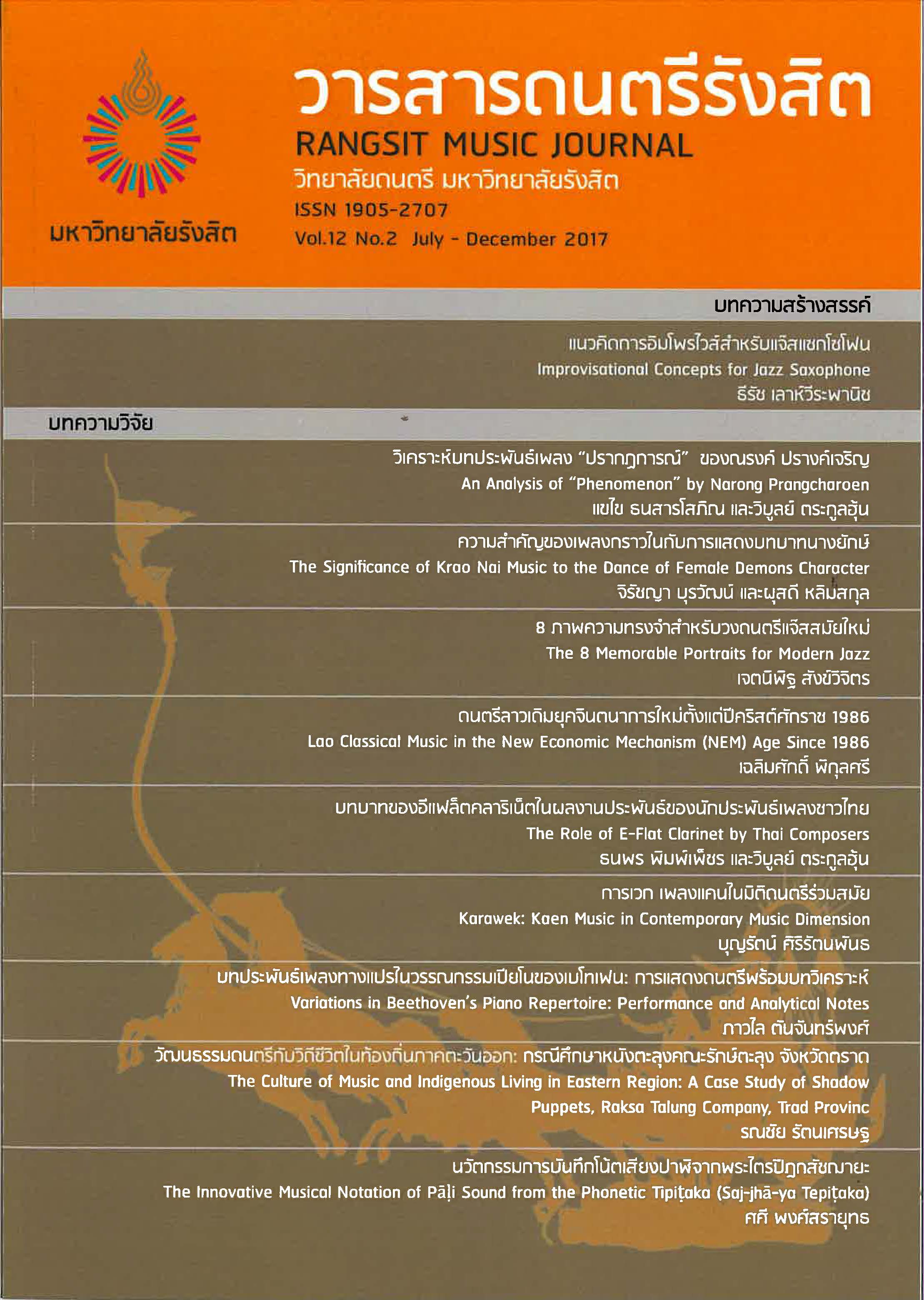นวัตกรรมการบันทึกโน้ตเสียงปาฬิจากพระไตรปิฎกสัชฌายะ
คำสำคัญ:
ปาฬิ, ศาสนาพุทธ, พระไตรปิฎก, การบันทึกโน้ตบทคัดย่อ
นวัตกรรมการบันทึกโน้ตเสียงปาฬิจากพระไตรปิฎกสัชฌายะนี้ เป็นการนำความรู้ของสัททะ อักขะระ-ปาฬิมาพัฒนาเป็นสัญลักษณ์ของโน้ตเสียงและการบันทึกโน้ตแบบตะวันตกที่เป็นมาตรฐาน การเขียนเสียงปาฬิได้แม่นตรงด้วยระบบสัททะอักขะระ-ปาฬิท าให้สามารถบูรณาการต่อจาก ภาษาศาสตร์สู่ดุริยางคศาสตร์ ผลผลิตที่ได้คือ โน้ตเสียงปาฬิและการบันทึกโน้ตเสียงปาฬิในระบบสากล โดยผลที่ได้จากการออกเสียงสัชฌายะตามโน้ตเสียงปาฬินี้ สามารถสร้างความพร้อมเพรียง และแม่นตรงเป็นมาตรฐานในการออกเสียงที่เป็นหมู่คณะได้ และยังสามารถเขียนเสียงปาฬิในพระไตรปิฎกปาฬิได้ทั้งชุดที่เดิมเขียนไว้ด้วยอักขะระของนานาชาติไม่น้อยกว่า 20 ล้านอักขะระ ในชุด 40 เล่ม นวัตกรรมโน้ตเสียงปาฬินี้จึงเป็นการบูรณาการสหสาขา ได้แก่ พระไตรปิฎก ภาษาศาสตร์ ปาฬิภาสา พุทธศาสตร์ และดุริยางคศาสตร์เข้าไว้ด้วยกัน เป็นการสร้างองค์ความรู้ใหม่ ในทางวิชาการ เพื่อศึกษาและฝึกฝนการออกเสียงที่เรียกว่า ‘สัชฌายะ’ ให้มีประสิทธิภาพยิ่งขึ้นในอนาคต อีกทั้งยังถือเป็นการอนุรักษ์เสียงปาฬิในทางวิชาการด้านต่างๆ ให้คลังอารยธรรมที่สืบทอด มาด้วยเสียงสามารถเผยแผ่ให้แพร่หลายได้เป็นสากลยิ่งขึ้น การสร้างสรรค์นี้มิใช่เป็นเพียงเปลี่ยนรูปแบบการเขียนเสียงเท่านั้น แต่ยังสามารถเปิดมิติใหม่ของเสียงปาฬิที่ซับซ้อนให้ง่ายขึ้นในการศึกษา ผู้อ่านโน้ตเสียงปาฬิสามารถอ่านออกเสียงปาฬิได้ชัดเจนก่อให้เกิดสมาธิอันสูงส่ง อันเป็นเป้าหมาย และกุศลของการออกเสียงสัชฌายะสมัยใหม่
เอกสารอ้างอิง
2. ชิดชนก เหลือสินทรัพย์. “กฎการตัดพยางค์จากคำที่เขียนด้วยอักขรสยาม-ปาฬิเพื่อการอ่านออก เสียงโดยอัตโนมัติ.” ใน หนังสือที่ระลึก 80 ปี ราชบัณฑิตยสถาน. บรรณาธิการ ราชบัณฑิตสถาน, หน้า 483. กรุงเทพฯ: อรุณการพิมพ์, 2557.
3. ณัชชา พันธุ์เจริญ. พจนานุกรมศัพท์ดุริยางคศิลป์. พิมพ์ครั้งที่ 4. กรุงเทพฯ: เกศกะรัต, 2554.
4. ธัมมจักกัปปวัตตน วรรคที่ 2 ตถาคตสูตรที่ 1 พระไตรปิฎก เล่มที่ 19. พระไตรปิฎกปาฬิ “จุลจอมเกล้าบรมธัมมิกมหาราช” ร.ศ.112 อักขะระสยาม (39 เล่ม). กรุงเทพฯ: มปท., 2436.
5. พระไตรปิฎกปาฬิ “สยามรัฐ” อักขะระไทย (45 เล่ม). กรุงเทพฯ: โรงพิมพ์มหามกุฎราชวิทยาลัย, 2536.
6. สุรธัช บุนนาค และสุชาติ วงศ์เกียรติขจร. “กระบวนการตัดพยางค์ คำปาฬิ-อักขระสยามเป็นพยางค์ เพื่อการอ่านออกเสียงปาฬิในอุปกรณ์อิเล็กทรอนิกส์.” สิทธิบัตรหมายเลข 1401005547. วิจินตน์ ภาณุพงศ์. “สัททอักษรไทยปาฬิ.” วารสารราชบัณฑิตยสถาน, 37(2) 2555: 247-263.
7. Apel, Willi. The Notation of Polyphonic Music 900-1600. 5th ed. Cambridge, MA: Medieval Academy of America, 1961.
8. Cole, Hugo. Sounds and Signs: Aspects of Musical Notation. London: Oxford UP, 1974.
9. MacGrain, Mark. Music Notation: Theory and Technique for Music Notation. Boston: Berklee Press, 1986.
10. Parrish, Carl. The Notation of Medieval Music. New York: Carl Fisher, Inc., 1946.
11. Read, Gardner. Music Notation: A Manual of Modern Practice. Boston: Crescendo Publishers, 1969.
12. Saulnier, Daniel. Gregorian Chant: A Guide to the History and Liturgy. Orleans, MA: Paraclete Press, 2009.
13. Stone, Kurt. Music Notation in the Twentieth Century. New York: Norton, 2009.







